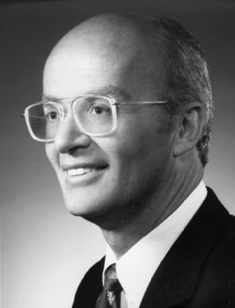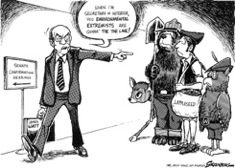Teaching the Article
Exercise 5
All of the materials associated with this exercise are available for download.
Evolution of the Environmental Opposition
In the 1980s, Ronald Reagan and his secretary of the interior James Watt attempted to roll back environmental protections for the nation’s public lands. Their actions provoked a powerful public backlash that swelled the membership and political strength of the national environmental movement. Twenty years later George W. Bush advanced an anti-environmental agenda that appeared to many observers as a return to the Reagan era. Yet, Bush’s actions, while controversial, did not spark the sustained expansion of the national environmental movement seen in the 1980s or draw the same degree of public outcry. Why?
When it comes to environmental reform, the Republican party has an especially checkered history. President Richard M. Nixon was a surprising ally to environmentalists. In the late 1960s and early 1970s Nixon competed with congressional Democrats, such as Edmund Muskie, for a leadership role on environmental initiatives and legislation. Through executive action, Nixon created the Environmental Protection Agency (1970), and he prodded Congress to pass other legislation, such as the Clean Air Act. However, Nixon’s support was not uniform. In 1972, he unsuccessfully tried to block clean water legislation. Overall, however, Nixon and other Republicans played an important role in dramatically expanding the federal government’s responsibilities for protecting the environment in the early 1970s.
The turning point for the Republican party on the environment came with the election of Reagan in 1980. Reagan was the first president who openly challenged the federal government’s role in protecting the environment. In Reagan’s view, federal environmental regulations stifled free enterprise and private initiative. He appointed James Watt, a like-minded westerner, as his secretary of the interior. Watt tried to make rolling back federal environmental regulations on public lands a centerpiece of the Reagan administration’s environmental agenda. It was that agenda that President George W. Bush seemed to embrace in 2001. Bush’s administration, as had the Reagan administration, gave priority to oil, gas, and other types of development and expedited environmental reviews on public lands. What explains the shift in the Republican party’s position on the environment between the 1970s and the early twenty-first century?
To fully answer that question would require examining a range of environmental issues, differences within the Republican party, and the importance of region to conservative politics. This article focuses specifically on the success Republicans had in harnessing populist anger over environmental protection in the West to the party’s national agenda. I argue that the sagebrush rebellion in the late 1970s and early 1980s (a populist protest against public lands reform supported by western citizens, the natural resource industries, and local and state governments in the West) and the wise use movement in the late 1980s and early 1990s were important examples of conservative citizen mobilization in the West. The westerners involved in these political efforts were often rural westerners such as loggers, ranchers, and recreationists, who had a personal stake in the future of the public lands. Although the sagebrush rebellion and the wise use movement opposed the role of the federal government in managing western lands, they expressed and organized their opposition in different ways. The sagebrush rebellion was poorly coordinated and more reactionary in its opposition to environmentalism, and it emphasized the rights of states to manage the lands within their borders. The wise use movement was a better coordinated network of local citizen groups and national organizations; it described itself as a new form of environmentalism and emphasized the rights of rural westerners to hunt, access public lands for recreation, and protect their private property. These changing strategies, important to the environmental opposition in the West, followed broader shifts in the strategies of the Republican party, which gradually adopted a new language that privileged rights-based claims to individual liberty and property in opposition to what they viewed as the threat of an invasive federal government.
Consider the following two sets of documents. The first set includes excerpts of speeches and addresses from presidents and their appointees that indicate how the Republican party was approaching environmental issues nationally. The second set includes excerpts of materials from the sagebrush rebellion and the wise use movement. As you read them, consider these questions:
Questions
- How did the approach of conservatives to environmental issues change between the 1970s and present? Why were rural westerners angry over environmental reform?
- What evidence is there for a shift in Republican rhetoric away from a reactionary opposition to environmental protection in the 1980s to a more positive strategy emphasizing individual rights in the 1990s and 2000s? Is that shift more relevant at the regional or national level?
- Why did the actions of conservatives provoke such a sustained and powerful backlash in the early 1980s and a less sustained response in the early 1990s or the 2000s?
Documents
Set 1
- Excerpt from Richard Nixon, “Special Message to Congress on Environmental Quality,” February 10, 1970.
- Ronald Reagan, “Message to Congress Transmitting the Annual Report of the Council on Environmental Quality,” July 21, 1982.
- James Watt, “Despite Critics, Interior Dept. Makes Rapid Progress,” Human Events (1982).
- Excerpt from George W. Bush, “President Bush Promotes Healthy Forests in Arizona” (2003).
- Excerpt from Lynn Scarlett, “Moving beyond Conflict,” Aug. 29, 2002.
Set 2
- Telegram from Ronald Reagan to Sagebrush Rebellion Conference, Nov. 20, 1980.
- Excerpt from Representative James Santini’s introductory comments in U.S. Congress, House, Committee on Interior and Insular Affairs, Sagebrush Rebellion, Nov. 22. 1980.
- Excerpt from testimony of Joe Lane, chairman of Public Lands Committee of the National Cattlemen’s Association, Nov. 22, 1980.
- Ron Arnold, “Introduction” in The Wise Use Agenda (1989).
- Ann Basker, Southern Oregon Resources Alliance, “Letter to President Bush” in The Wise Use Agenda (1989).
- Sally Saxon, Northwest Legal Foundation, “Letter to President Bush” in The Wise Use Agenda (1989).



